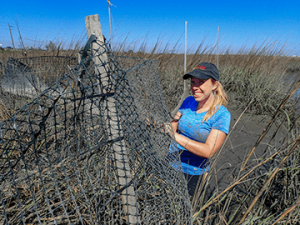Interdisciplinary Ecology doctoral student Julie Walker recently published research on the saltmarsh-mangrove ecotone. Specifically, the study examined the changing vegetation composition between the two ecosystems. Walker also wanted to know how that change impacts community structure, ecosystem functioning, and predator-prey interactions.

“Fewer freeze events due to climate change are enabling mangroves to expand their range,” Walker said. “As these tropical trees expand poleward, they are replacing herbaceous saltmarsh vegetation.”
Mangroves and saltmarsh vegetation are “ecosystem engineers” that are typically viewed as having similar ecosystem functions, but in her research, Walker and colleagues manipulated predator access to marsh and mangrove creekside habitats to test their role in mediating vegetation and invertebrate structure and stability in a two-year experiment. Another part of the research included a survey to evaluate how shifting vegetation is modifying structural complexity, invertebrate communities, and ecosystem functioning at the ecotone.
“Excluding larger predators (greater than 2 cm diameter) did not affect vegetation or invertebrate structure or stability in either saltmarsh or mangrove habitats,” Walker explained. “The survey revealed that the two habitat types consistently differ in structural metrics, including vegetation height, inter-stem distance, and density, yet they support similar invertebrate and algal communities, soil properties, and predation rates.”
Findings
The research shows that although mangrove range expansion immediately modifies habitat structural properties, it is not altering larger predator consumptive effects, community stability, community composition, or some other ecosystem functions and properties at the ecotone.
You can read the full research article online in the open-access journal Diversity.
Walker collaborated with Dr. Christine Angelini and Dr. Andrew Altieri from the UF Department of Environmental Engineering Sciences, Dr. Ilgar Safak from the UF Civil and Coastal Engineering Department, and Dr. Todd Osborne from the UF Soil and Water Sciences Department. Angelini and Osborne co-advise Walker on her dissertation work in the UF School of Natural Resources and Environment.
 0
0
